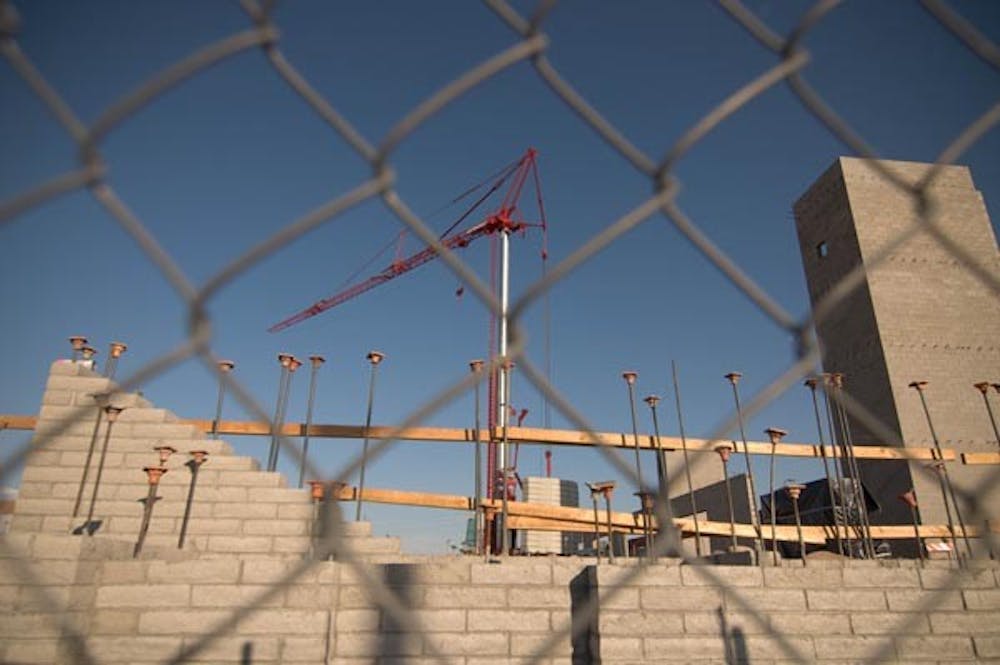After more than a decade of discussion within Tempe’s deaf community, a residence specifically tailored toward the hearing impaired is well underway.
Apache ASL Trails, near Apache Boulevard and Price Road, is the first development in the Southwest targeted specifically toward hearing impaired seniors. The housing represents a collaborative effort from the Arizona Deaf Senior Citizens Coalition and Cardinal Capitol Management Inc., a Wisconsin development company, to create a unique residence for the deaf community.
At the brink of light rail construction, 14 apartment buildings were assembled around the tracks as a new wave of expansion swept Tempe in 2008.
Today, as a poor economy grips the housing market, Apache ASL Trails is the sole project being developed in Tempe — a sign of a transition from luxury condominium projects to low-income housing.
The $16 million affordable housing project is marketed toward deaf community members who are below the 60 percent median income, said Cindy Coen, assistant deputy director of programs for the Arizona Department of Housing.
“As the seniors retired from their jobs and their kids were growing up and moving away, they were again encountering the isolation that is amplified for people who are deaf,” she said. “When the children who have been signing with you for that last 20 years move away, you have a giant gap.”
The 75-unit residence is within walking distance to the Valley Metro light rail as well as the bus line, Leiterman said. Only about half of the deaf population gets a driver’s license and learns to drive because the vulnerability they feel.
“As they age and their eyesight starts to go as well, they have two impaired senses,” she said. “Even those that are able to drive give up their cars earlier.”
Residents were thrilled to find that the apartment complex was near the light rail and bus, Leiterman said. The deaf population uses rapid transit very heavily, so that type of transit-oriented location is critical.
Members of the coalition had discussed boarding schools that had enabled deaf students to live and study together, and thought that this could apply to them. Congregate living seems to be the preferable living method to bridge the communication gap that hearing seniors face on a daily basis, and has been a community discussion for many years, Coen said.
“Even through the credit crisis, and funding becoming a real problem, we did manage to find investors who were still interested,” said Judy Leiterman, asset manager for Cardinal Capital Management Inc.
There is still a mandate and mission through the Community Reinvestment Act that requires federally regulated banks and financial institutions to reinvest in their community, she said.
The Community Reinvestment Act is intended to encourage institutions to help meet the credit needs of communities in which they operate, including low-income neighborhoods, according to the federal website.
In spite of the difficult times, it is good for the community to embrace a development that really revitalizes an aging community, she said.
“We have worked really hard on this project and it is actually being built,” said Chris Anaradian, Tempe’s community development director.
The economic impact has reprioritized development in Tempe, Anaradian said. Projects like Apache ASL Trails now have the chance to happen in the halted state.
Affordable housing projects like Apache ASL Trails can now be taken off the back burner and turned into a reality for community members, he said.
Projects like this are more common now that the private sector of development has taken a back seat. Public funds in the form of grants and tax-assisted funds are now sought to cover development expenses.
Faced with roadblocks like loans and other financial costs, private developers have put many of their plans on hold, Anaradian said.
“This isn’t the typical project,” Coen said. “We normally don’t have this type of financing, so this is a one-shot deal.”
Leiterman said developers who were riding on the real estate bubble were not concerned about housing the poor or disabled population.
“They can make buckets of money on condominiums,” Leiterman said. “That is not going to help them in the current market.”
The main design of the building incorporates American Sign Language into special interior features that maintain and uphold high safety standards.
The high-tech structure was designed by a deaf architect who is very aware of the building designs that can enhance a deaf lifestyle, she said.
The placement of windows helps minimize glare, allowing for better vision. Dark colored walls serve as a dark contrast in the room so residents can sign with ease. The rooms are also designed with open lines of sight without beams or pillars in the way. Lighting fixtures are also placed over work areas in such a way that it doesn’t interfere with the ability to see someone on the other side. All of these details will allow the deaf community to live easier and in a more comfortable lifestyle.
“Design is important, but even more important is the ability to communicate every day with people in American Sign Language,” Leiterman said.
Valley Center of the Deaf will also have full-time social workers on site in the 10,000-square-foot commercial space, designated specifically for instructors, ASL interns, possible classrooms and medical groups, she said.
The Apache ASL project was awarded tax credits in 2009 by the Arizona Department of Housing. The low-income taxing program is mandated by section 42 of IRS guidelines, which state that the project must be finished 12 months after it was initially awarded the credit, Coen said.
At this time, 30 applications have been approved with another 50 in the pipeline, Leiterman said. There is plenty of interest in the project that will be finished in June 2011.
“The tenants who are waiting to move in are so excited,” she said. “It is a dream come true to them.”
Reach the reporter at amoswalt@asu.edu





